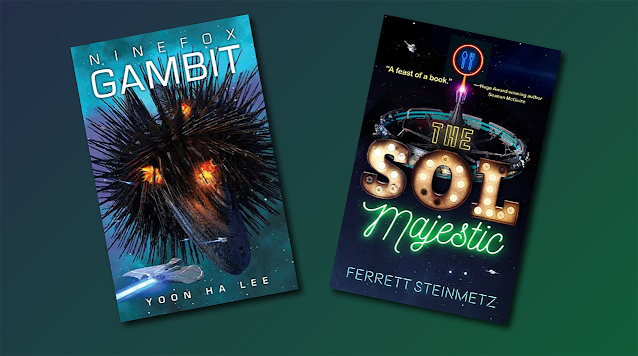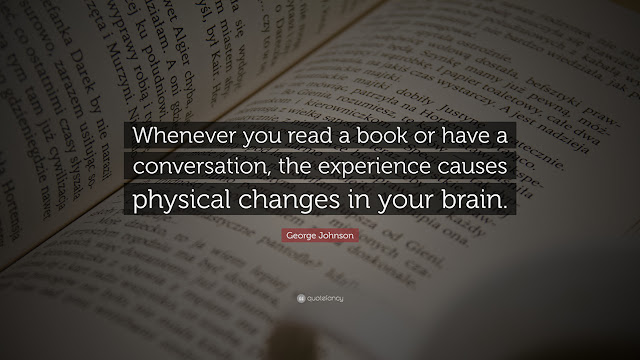The quote-image below has been a consistent favorite (among my most-clicked-on) since I first published it in January 2018. For a science fiction writer, “the future is something we create” has a double meaning, of course (I’ll get back to that in a bit). But if we’re creating our future through our collective choices and actions, what kind of future are we making? Consider the view from where you stand today. Is it truly the future we want?
 |
| This image has been a multi-click favorite of my readers since January 2018. (See credits below). |
Wait! Doesn’t COVID prove we’re not in control? That we’re at the mercy of random events? Certainly, out-of-the-blue events lurch into our lives. It’s inevitable. Everyone’s future comes packed with forces and events beyond our control.
Throughout time (and probably space, too), unexpected adversity has popped up to complicate things. We’re not responsible for what happens to us or how we feel about it. But we are responsible for what we do in reaction. Therein lies the test of our character.
 | |
| Our reactions to adversity define the quality of our character. (See credits below). |
The Future we Want for Ourselves
It helps to have a clear vision of what you want. As most dancers, martial artists, and other athletes will agree, if you envision doing something – and how you will do it – it helps you perform difficult plays or moves.
But when we apply that principle to life, we need to be careful what we wish for. I’ve known people who envisioned success in the form of tangible items. In my experience, that rarely ends well. You can envision driving a luxurious car or living in a gorgeous house, but how will that help you get there? As a result of that vision, will you do anything to get money?
My sister did an excellent job of explaining a better way to follow a guiding vision in the last two posts. Here are links to her How Did I Get Here? and What do You Want to be When You Grow Up? In her case, the guiding vision was “I want to work in the arts!” and she gave great illustrations of how that worked for her. I don’t need to cover that ground again.
 | |
| It took a while to find this quote properly attributed to its originator. (See credits below). |
The Future we Want for Our World
Today, I’m more concerned with our collective view of the future. It’s a question that has popped up in my life, in one form or another, rather persistently in the last few days. Recent polling seems clear: if you asked a random collection of Americans if we’re headed in a good direction they’d say “NO!”
But are we, to paraphrase the common paraphrase of Mahatma Gandhi, being the change we want to see? What needs to change, and what can we do, individually and collectively, to make that change happen? Ideas vary. But if you’re into New Year’s resolutions, how about resolving to think of people who disagree with us not as morons or buffoons, but as generally not that different from us. Maybe with some peculiar ideas, but not horrible people. Where are the points of commonality? Only from a place of connection can people begin to listen to each other.
Heck, if everyone made a New Year’s resolution (and then stuck to it) to only leave comments online that they’d be willing to say to the other person’s face in real life, we’d be well ahead.
 |
| Here’s a good way to start “being the change.” (See credits below). |
Envisioning The Future We Want Through Science Fiction
I’ve written before on this blog about ways that science fiction and speculative fiction has occasionally shaped public understanding. When authors explore complex or unusual ideas in compelling stories, they make them more relatable. The “Robot” novels of Isaac Asimov offer just one example.
Many of the most famous and influential science fiction novels or movies are thought experiments about how a new idea or trend or invention might change things if taken to a certain extrapolated level. Often, as in The Handmaid’s Tale, things are taken to an extreme that makes the point hard to overlook.
Unfortunately, all too often the impulse to explore an idea in an extreme version distorts things. The author must downplay or ignore safeguards in the real world, many times without much (or any) explanation of why that safeguard failed in their story’s universe.
 |
Visionary science fiction books from earlier decades. (See credits below). |
The Two Novels That Inspired this Post
I normally have several books going at once, but rarely two novels at the same time. More often it’s one novel or anthology (for both pleasure and to keep up with the field) at a time. There usually are at least two nonfiction books for research on different topics. And there also is normally at least one book on the craft of writing.
However, this time (for complex reasons) I’m reading two different science fiction novels in parallel. I’ve only just begun them, so I can’t in fairness say anything yet about my sense of the stories. One is the military sf novel Ninefox Gambit, by Yoon Ha Lee. The other is more “general sf”: The Sol Majestic, by Ferrett Steinmetz.
Neither is a newly-published book. Ninefox Gambit is Book One of a trilogy. It’s set in a larger universe of stories that range from novels to short fiction to games, and more. As far as I can tell, The Sol Majestic is a standalone. Both were published by established publishers. But wow! Are they ever different.
 |
| Jan started these novels at roughly the same time. The comparison inspired this post. (See credits below). |
Worldview and Approach
Neither universe seems like a very good place to live, but the tone of each world is quite different. We’ll see where they go from here, but the two setups lead me to believe they’ll open out into very different experiences.
My point in mentioning them is to say that opening oneself to new views and ideas can change how we look at the world we live in now. The stories we choose to consume shape our worldview in ways that range from subtle to profound. When we read wildly different books, set in wildly different places and worldviews, we grow more mentally flexible.
The opposite is also true, however. If we only ever tell ourselves one kind of story, over and over and over, it distorts us. What kind of stories should we not get too comfortable with? I’d suggest that too total a diet of conspiracy theories, myths about the Lost Cause, or even science fiction stories that are always predicated on “we destroyed Earth, so we have to find someplace new” might become a problem.
Does it help us create the future we want? That’s a question we probably should ask, especially if we get really, thoroughly dialed-in on any particular worldview or philosophy, to the exclusion of everything else.
 |
| What you read and what you discuss really does make a difference. (See credits below). |
IMAGE CREDITS:
I’m sorry to say that QuotesHunter (my original source) doesn’t seem to be around anymore, but you can still find the header image on my Artdog Adventures post “Creating Well.” I found the words for the quote from John W. Holt, Jr. on Quote Master, but the quote-image format wasn’t right for this blog. So I made my own, using a stormy background by plus69 on 123rf.
Many, many thanks to Quotespedia, for the often-unattributed Sean Patrick Flanery quote and the nice image to go with it. We also want to thank “Sheila Pennies of Time” on Pinterest for the “random act of kindness” quote-image with the quote by the mysterious Martin Kornfeld (I can find his quote many places, but nothing about the man himself). I can’t find a source beyond that Pinterest page. I first posted it as an “Artdog Quote of the Week” in 2017. For this post, I have adjusted the format to take up less vertical space without losing any of the picture.
I took the photo of my three copies of the Isaac Asimov “Robot” books (The cover art for The Caves of Steel and The Naked Sun are both by Stephen Youll. Cover design for The Robots of Dawn is by Kiyoshi Kanai.) The cover image for The Handmaid’s Tale is courtesy of Bookshop. We’re grateful for the cover images for Ninefox Gambit and The Sol Majestic, both from Goodreads. And finally, Quotefancy came through for us with the George Johnson quote about changes to our brains (check out his appearance on The Colbert Report). Many thanks to all!
No comments:
Post a Comment